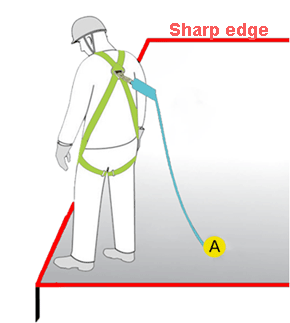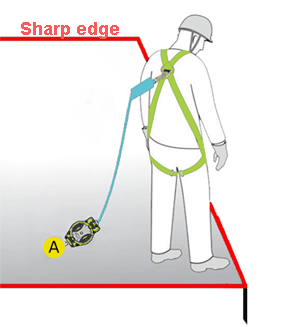What is the difference between clearance and clear distance under the work area?
The clearance is a distance between the anchorage point and the first obstacle, including a 1 m safety distance
The clear distance under the work area is a distance between the working area (= at the level of the user's feet) and the first obstacle, including a 1 m safety distance
Example of clearance for lanyards with energy absorbers
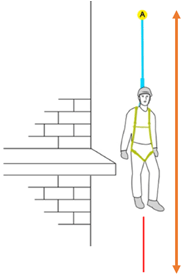
Safety distance = 1 m
Example of clear distance under the work area for retractable fall arresters
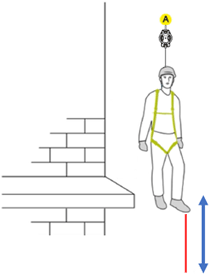
Safety distance = 1 m
NB : ![]() = Anchorage
= Anchorage
For retractable fall arresters, we ONLY consider the clear distance under the work area and not the clearance.
Why ? Because, depending on the type of retractable fall arrester, the position of the anchorage point may vary in distance from the user, so it is simpler for retractable fall arresters to refer to clear distance under the work area.
These distances are calculated using various parameters:
- the selected fall arrest system: our i-beSafe calculator calculator takes into account two types of fall arrest systems: lanyards with energy absorbers and retractable fall arresters;
- the fall factor, or the work near a sharp edge (see the explanation below).
Before each use of a fall arrest system, check the clear space under the work area to avoid impact with the ground or any other obstacles in the path of the fall (this space may change over the course of the day!).
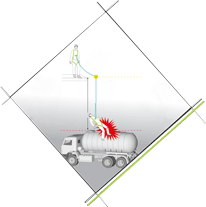
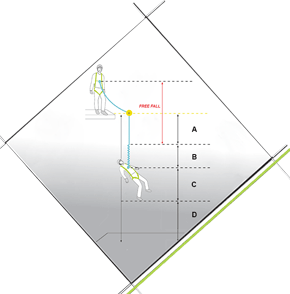
Clearance for lanyards with energy absorbers
Caution: for a lanyard with energy absorber, the clearance is expressed as below the anchorage, and it can also be considered under the user's feet (work area)
A= Length of the lanyard
B= Absorption distance
C= User height, approx. 1.80 m (from feet to the attachment point on the harness)
D = Mandatory safety distance 1.00 m
CLEARANCE
= A+B+C+D
Clearance for retractable fall arresters
Caution: for a retractable fall arrester, the clearance must be expressed as below the user's feet = clear distance under the work area, not under the anchorage, since it may be several metres above the working area.
A= Required locking distance
B= Absorption distance
C= User height, approx. 1.80 m (from feet to the attachment point on the harness)
D = Mandatory safety distance
1.00 m
CLEAR DISTANCE UNDER THE WORK AREA
= A+B+C+D
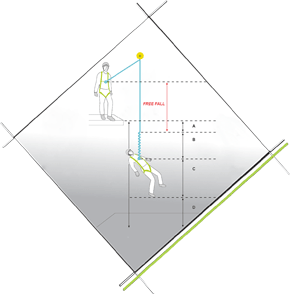
Understanding the concept of sharp edges:
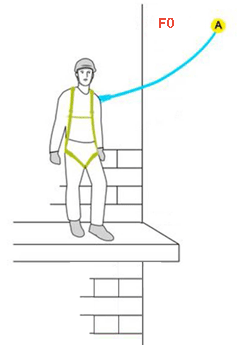
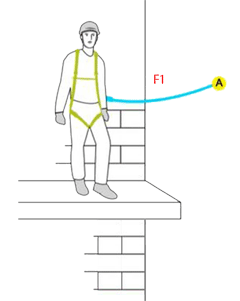
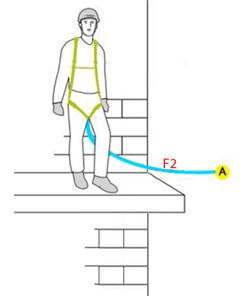
Generally, the fall factor is expressed as: Factor 0, Factor 1, Factor 2.
It is important to understand that the fall factor is a ratio between the height of a person's fall and the length of their fall arrest system.
Here is an example to help understand:
A user works using a 1.50 m lanyard and at a height of 0.50 m above his/her anchorage point. If he/she falls, the fall distance is: 1.50 m + 0.50 m = 2 m.
In this particular work situation, the fall factor is: F=2/1.50 = 1.33.
Key takeaways:
- anchorage point is positioned above the user: Factor 0;
- anchorage point is positioned at the user’s shoulder level: Factor 1;
- anchorage point is positioned at the user’s foot level: Factor 2.
WHENEVER POSSIBLE, CHOOSE TO WORK WITH A FALL FACTOR OF 0
They demonstrate how the fall factor affects the result of the clearance or clear distance below the work area.
The greater the fall factor (factor 2), the larger the clearance/clear distance you will need under the work area to stop the fall.
Understanding the concept of sharp edges:
When a user moves HORIZONTALLY with a fall arrest system anchored at foot level AND he/she moves close to a sharp edge (e.g. roof edge, concrete wall, fall through a fragile roof, etc.), we are referring to working near a sharp edge.
And regardless of which fall arrester is used (an energy absorbing lanyard or a retractable fall arrester) the clearance or the clear distance under the work area after a fall will be equivalent.
The presence of a sharp edge requires the mandatory use of a suitable fall arrest system. WARNING, not all of them are!
Check the instructions to ensure that the fall arrester is approved for this use. It must be tested according to:
- VG 11 RFU 11.074 for lanyards with energy absorbers;
- VG 11 RFU 11.060 for retractable fall arresters.
Work near a sharp edge
